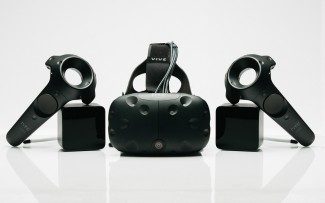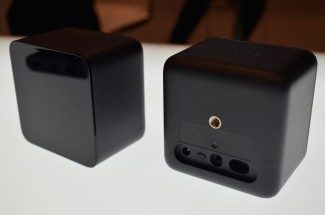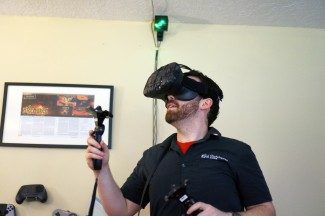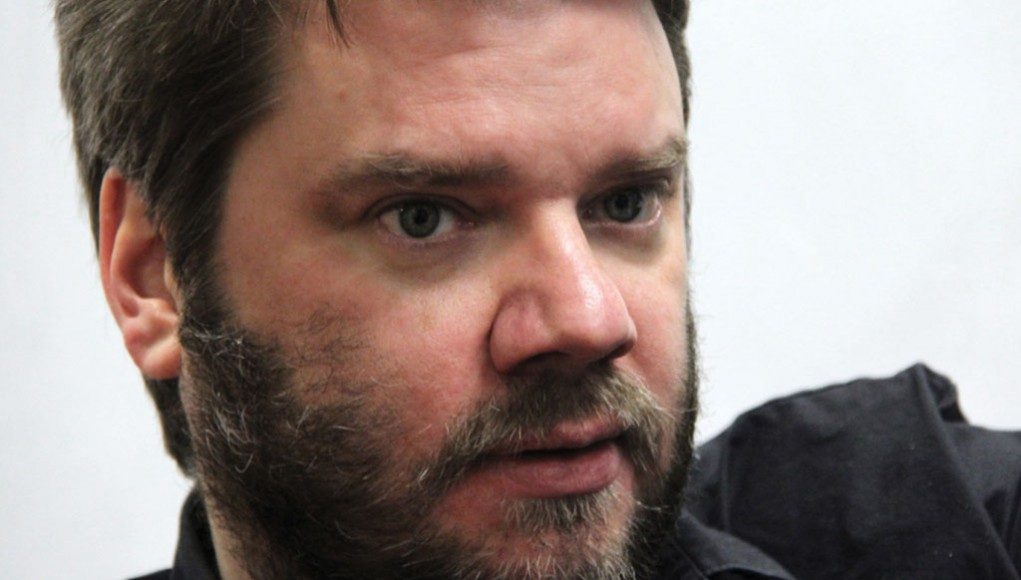I sit down with Valve Writer, Game Developer and seemingly omnipotent VR Evangelist Chet Faliszek to discuss the new Vive Pre, Valve’s focus on a safe VR experience, expectations for the upcoming VR content showcase and his startlingly sneaky cat.
On my final day at CES in Las Vegas, I managed to snag some more time on the new HTC Vive Pre, focusing this time on the new headline features, Mura correction and of course the new front-facing camera. Executive Editor Ben Lang went hands on with the new hardware and shared his thoughts here.
After the experience, I was able to sit down briefly with Valve’s most visible of virtual reality evangelists, Chet Faliszek.
Always pleasant and genial, I’ve included Faliszek’s answers pretty much verbatim below, with just my questions edited for clarity and to curtail the overt rambling brought on by a very long week at CES.
Road to VR: The new Vive Pre headset has a front facing camera, will Vive’s Chaparone system now alert you if, say, your cat decides to walk across your path whilst you’re in VR?
Faliszek: So, our original intent when we started working on the original Chaparone system has always been to make sure that you’re safe no matter what the conditions are going forward. So this was the first showing of our front-facing camera and its capabilities, and we’re going to keep to it. We’ll see what we’re shipping, I don’t want to make any promises of what we’re shipping and when we’re shipping it, but the goal is always for safety and always to help.
Shout out to my cat Bella … she already knows how to open every door in our house, she now realises when she comes in my office I have to get up and close the door, so she politely closes the door about 50% of the time, which means if I have the headset on, I don’t know she entered, but she’s there.

Road to VR: It looks like you’re doing some edge detection with the front facing camera on the objects that are moving, is that purely an image processing effect?
Faliszek: Why we’re so careful about saying it’s a front facing camera over a pass through camera is that we’re not sending the video signal through, we’re sending the data through and that allows us to do things like the edge detection and some other features on there. One of the things you have to make sure is that as you’re sending that data back you’re not adding any latency, there’s no weird motion.
Road to VR: Are you saying you’re doing processing on the headset before you’re sending the data back?
Faliszek: We’re not talking about what’s happening where, it’s more that we’re showing it happening. If you’re in the [VR] experience, feeling safe in that experience means that you feel a greater sense of presence. We’ve learned through experience that the more things you have to juggle in your head, the less you can lose yourself in the experience. And while it sounds counter intuitive to say “Hey! We’re going to show you the real world and that’ll help you stay in the experieince,” it actually does. I don’t know about you, but I don’t have a 5 metre across office, my office is a bit more humble. So that means that my track space also includes above my desk and above my TV credenza, there’s a larger area I can physically walk, but now as I’m playing I can see this is a safe place to interact.

Road to VR: As VR headsets are now so close to consumer ready, the focus must turn to the content. Almost every developer we speak to seems to already have a Vive developer kit, which means you’ve sent a huge amount out there. Would you hint at the number of developers working on Vive content?
Faliszek: Lots! It’s just because some developers are private, some developers are going to surprise you, there’s just so much going on that we always just let the developers speak for themselves.
Road to VR: Are we talking 1000s or 100s?
Faliszek: I honestly don’t know the number. I barely know my name, it’s Friday at CES!
Road to VR: You’re ramping up towards release of the Vive now, and as you watch people using the system, and you’re thinking about what that launch content line up’s going to have to be, what are your thoughts on what you think should be in that line up?
Faliszek: Well I think you want a wide range of experiences. It’s weird, some things are no longer games, they’re experiences and then some things are passive content. I think just a wide range of what people want. The device does lots of things really well and it’s nice to come home and put it on and you can just put some music on and play some Tilt Brush if you want, it’s a relaxing experience.
So, I’m a gamer. I play TF2 or Battlefield 4 every night. Battlefield lends itself to my play style, essentially I’m old and less reaction-ary. And I think in the same way that I come home and play those games, we’re going to start seeing those kinds of traditional experiences that I gravitate towards are coming out and will start being represented. We’re kinda holding stuff back for the Content Showcase at the end of this month, where people will start seeing those kinds of things. I think there’s a lot of people now who look at the content and think “Oh, that’s great I could play that, I wanna see that, this is really fun,” and there are some hardcore gamers that are like “I don’t know if I’m seeing the content I’m used to playing, I play this for a story but I also wanna play this and where’s this part of it,” and I think you’re gonna start seeing that kind of content that they’ll come back to and play.
Road to VR: Do you have an idea for the exact set of games you’ll be launching with in April?
Faliszek: All of that stuff we’ll be talking more about at the Content Showcase. This week’s more about the hardware and how that allows for those experiences to happen.

Road to VR: I know that Valve’s Alan Yates, the engineer behind the Vive’s Lighthouse tracking system, is unhappy with the current crop of 360 videos being touted as VR experiences. Is that a view shared across Valve?
Faliszek: So 360 video on the desktop, let’s be super clear is super awesome, super fun. I think when people equate that to virtual reality, they’re short selling what virtual reality is. I mean when you move you wanna move, and see that reflected back to you. And I think also we’ve done so much work on the photogrammetry stuff – when you’re in the volcanic fields of Iceland you actually can move around in them and see them and you’re brain is just like “this is where I am, why isn’t it cold?”. And I think those move you so much greater than some of what you see with the 360 video.
There’s this rush of “Oh, we’re gonna be able to be ‘at’ concerts now,” but you know, they film concerts now. And what I actually find I like is, I like having a directorial voice showing me what to look at. Valve’s always been about trying to give you agency in the world, trying to have you ‘be’ that person in the world an to have those kinds of experiences.
Road to VR: How large an event is the Content Showcase coming up at the end of January?
Faliszek: We’ll be talking more about that soon. And to be clear, that’ll be highlighting [content], it won’t be like “this is it!”.
Road to VR: Will we find out more about that launch line up?

Faliszek: Eventually we’ll start talking about that, well, probably the developers will start talking about that. I would much rather you be talking to developers than me, because I would much rather have them say the things they want to say and if they happen to be saying something negative about the Vive or whatever, we should fix that. And our goal’s always like let’s keep fixing things until there’s nothing negative to say but to always let them [developers] talk.
Road to VR: Any surprises coming at the Content Showcase, do you have new content out that we haven’t seen before, something that you’re really proud of?
Faliszek: There’s stuff I’m really excited about now that I have a lot of fun playing.
Road to VR: That we have or haven’t seen?
Faliszek: That you haven’t seen. There’s stuff that I go home and I play regularly, every night (when I am home), that is stuff that no one’s heard about, don’t know is being made, and I think that’s one of the exciting things. There’s a bunch of content coming out and it’s a really exciting time for developers. We want VR to succeed, that’s super important for us. But more important than that is, that we want to make sure that developers don’t get burned. We’re trying to do everything we can for them. We’re [Valve] funding development as well, I know HTC is as well. You couldn’t guess who we are as we don’t think they should be exclusive to our hardware.
You know, I think you can look through the history of game development and there is a graveyard of companies that have pinned their hopes on that. And for us, we’ve been doing this for ten years, we’ve worked with these developers, they’re our friends, they’re our partners, and we wanna make sure they succeed. So, a lot of what we’re doing is trying to help them succeed. We hate the word ‘ecosystem’, but a good ecosystem of virtual reality where they can thrive on that. They should be on every platform, and that’s what we’ve always said to every developer.
Road to VR: So as you’re flying around the world, evangelising VR, is Bella the cat fed up with you not spending any time with her?
Faliszek: Oh I’m gonna pay the price for this one. She will sit on me and not get off.
My thanks to Chet for taking the time to speak with us. We’re now more curious than ever to see just what juicy content morsels turn up at Valve’s Content Showcase in Seattle at the end of this month. Road to VR will be at the event to bring you all the details direct.







